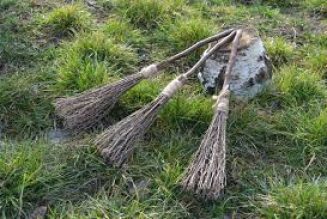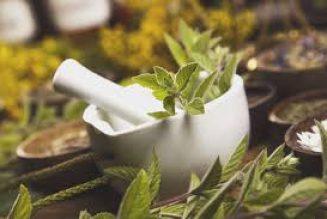Meadowsweet is a member of the rose family and can easily be found growing wild along streams and rivers, as well as damp woodlands. It is a high altitude plant that can grow as high as 3,300 feet. It is native to Europe and Asia and was successfully introduced and naturalized in North America. It has a tuberous root that is the key to its scientific name. The name meadowsweet is an Anglo Saxon name, which comes from the fact this herb was used to make mead, and drink made from fermented honey. Another strewing herb, tossed on the floor in the 16th century to warm and scent the floors and keep infections at bay, this was a favorite of Queen Elizabeth the I who preferred it in her bedroom. Gerard, an early herbalist, believed it outranked all other strewing herbs because the scent was delightful and did not cause headaches by being over powering. It was a traditional plant of druids and was in the most sacred category along with mistletoe, watermint and vervain. The sap contained in the branches of Meadowsweet contains a chemical called salicylic acid. Isolated in 1853 by an Italian professor, Bayer formulated acetylsalicylic acid in 1899, they called it aspirin after the old botanical name for Meadowsweet, Spirea ulmaria. The herb is considered much less harsh to the stomach than aspirin. Meadowsweet is especially suited to headaches in which the person has a hot head and feels a pounding sensation in the head. Meadowsweet is cooling and it promotes circulation, which can relieve stagnant energy in the head. Besides having the ability to relieve pain, meadowsweet is also anti-inflammatory in nature. Taken daily as a tea or tincture it can help relieve chronic arthritic pain and inflammation. Stomach aches and acid reflux. My favorite herbs for stomach aches and nausea are ginger, peppermint and meadowsweet. Meadowsweet shines as an herb for stomach aches, nausea and poor digestion and is especially helpful for those who find herbs like ginger to be too warming. Meadowsweet removes stagnation (like when you eat a meal and it stays in your stomach too long) and relieves discomfort in the stomach. To GrowThis hardy perennial grows 2 to 4 feet in height with a spread of 2 feet. Clusters of strong scented creamy-white flowers in mid-summer. The leaves are deeply veined and appear in groups of two to five. All meadowsweet variety are hardy in Zone 4. The seed can be stratified, but is not required. To stratify the seed you need to to place them in a situation where extreme cold will break down the seed coat and end their period of dormancy. Placed in a plastic bag filled with damp sphagam moss or a damp paper towel for a couple of weeks usually does the trick. If in a hurry, run the seeds over a nail file to break the seed coat before planting. Sow prepared seed or plug trays in the autumn. Cover lightly with soil and winter outside under glass (a cold frame would work perfectly. Check from time to time and water as needed when dry. Germination should take place in the spring. When the seedlings are large enough to handle, plant out 12 inches apart into a prepared location. You can also propagate by division. The golden and variegate styles must be propagated by division. In the fall, dig up established plants and tease the plantlets apart; they separate easily. Replant in a prepared site or place in pots. A soil of bark, peat and potting soil works perfectly.The plant prefers sun and semi shade and a moisture retaining soil. If your soil drains well, you will need to add rotten manure or vegetative compost and leaf mold and plant in a more shaded area. Once a plant is established you will need to lift and divide it every 3 to 4 years in the fall to keep it vibrant. To Use Gather young leaves for fresh or dry use before slower appear in mid-summer. Pick flowers just as they open and use fresh or dry. Meadowsweet leaves and flowers can be made into an herbal vinegar that is sweet and lovely for salad dressings. You can also make fritters with the flowers or use them to flavor mead and beer or to make wine. The whole plant is a traditional remedy for an acidic stomach. The fresh root is used in homeopathic preparations and is effective on its own in the treatment of diarrhea. The flowers, when made into a tea are a comfort to flu victims. A black dye can be obtained from the roots when used with a copper mordant, while the flowers can produce a greenish-yellow dye and the leaves and stems make a blue dye. One can also use the dried leaves and flowers in potpourri.A tea made with leaves and flowers will help the body of excess fluid and alleviate heartburn. It is also a treatment for feverish colds and mild diarrhea. It even works as a mild sedative and painkiller. Use one teaspoonful of dried flowers and/or leaf blend to each cup boiling water. Infuse for 10 minutes and drink warm. Add honey and cinnamon to improve taste and soothe sore throats To make a meadowsweet beer; boil 2 ounces each of meadowsweet, betony, raspberry leaves and agrimony in two gallons of water for about 15 minutes. Strain and add 2 pounds of white sugar, stirring to dissolve. Bottle when nearly cool. Add the leaves to soup for a unique and interesting flavor. You can add the flowers to jams and stewed fruit which lends a slight almond flavor. RECIPES Meadowsweet SorbetMeadowsweet sorbet is a special treat. Its relaxing flavor will have you oohing and ahhing with your loved ones. 4 handfuls of Meadowsweet flowers½ pound brown caster sugar3 juiced lemons1 thinly grated lemon rind3 cups of water Directions:Put sugar into water, stir and bring to a boil. Rapid boil the sugar water for 10 minutes to produce a light syrup. Remove the pan from the heat. Now add the juiced lemons and the thinly grated lemon rind. Stir. Next add the Meadowsweet flowers. Stir. Allow to infuse until the syrup is cool/cold. Strain the syrup through a muslin and freeze in a plastic container overnight. Now take out your frozen Meadowsweet syrup (it won’t be that frozen), and blend with a hand-blender until smooth. Then put back in the freezer for 24 hours. Take out and blend again, then freeze for a further 48 hours. Enjoy. Meadowsweet Elixir (From Rosemary Glasdstar) 2 cups meadowsweet flowers2 cups vodka (50% is best)½ cup (scant) glycerin Directions:Place the meadowsweet flowers in a jar. Add the vodka and glycerin to the jar. Shake well. Let this macerate for 4-6 weeks and check on it often. You may find that as the flowers soak up the alcohol and glycerin, the liquid will no long cover the herb. To remedy this you can take a clean stone or weight and use it to weigh down the flowers below the liquid. If necessary, you can add a bit more alcohol to cover the herb. I opened my jar frequently and pushed down the flowers and that seemed to work just fine. Once you are done macerating the herb, it’s time to strain off the mixture. The easiest way to do this is strain it through a cheese cloth which you then squeeze the dickens out of until you get all the moisture from the flowers. Once it is strained you can bottle and label it. Meadowsweet is safe for most people. However, it should be used with caution for the following people
- children under 16 who have the flu or chickenpox symptoms (because of the rare but serious Reye’s syndrome)
- people with asthma (may stimulate bronchial spasms)
- people who are allergic to aspirin
- As with many herbs Meadowsweet should be avoided when pregnant or breastfeeding.






















